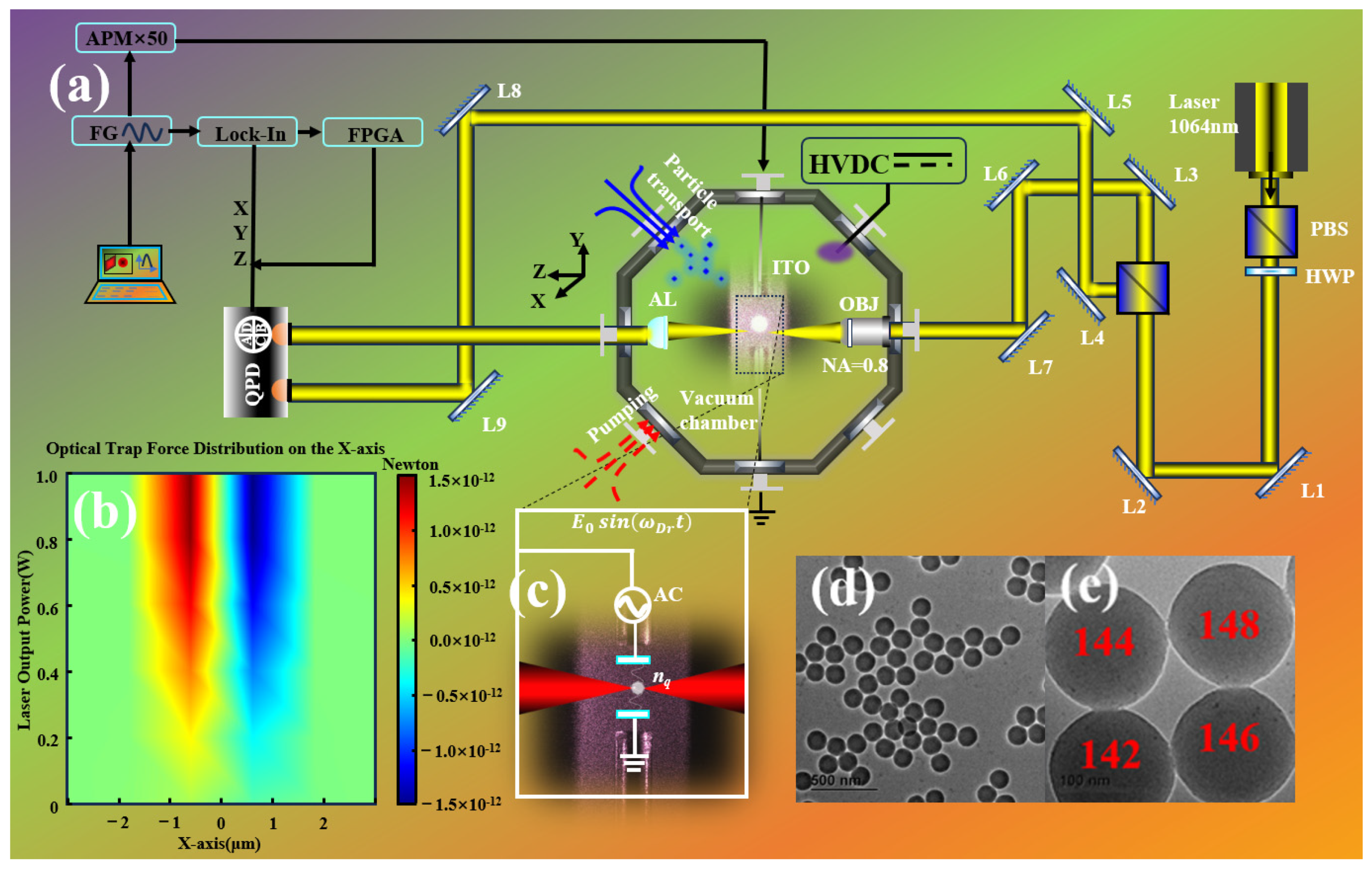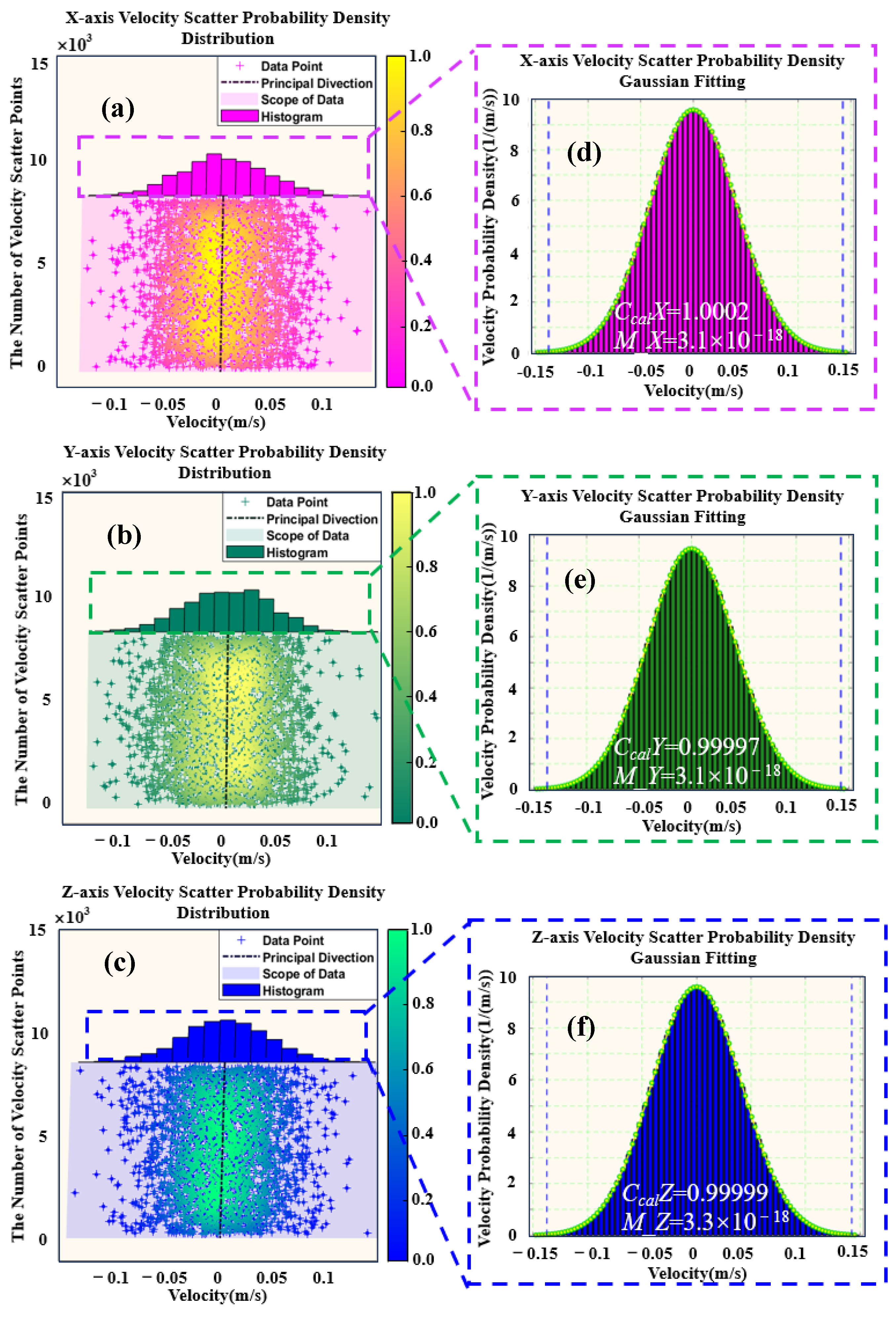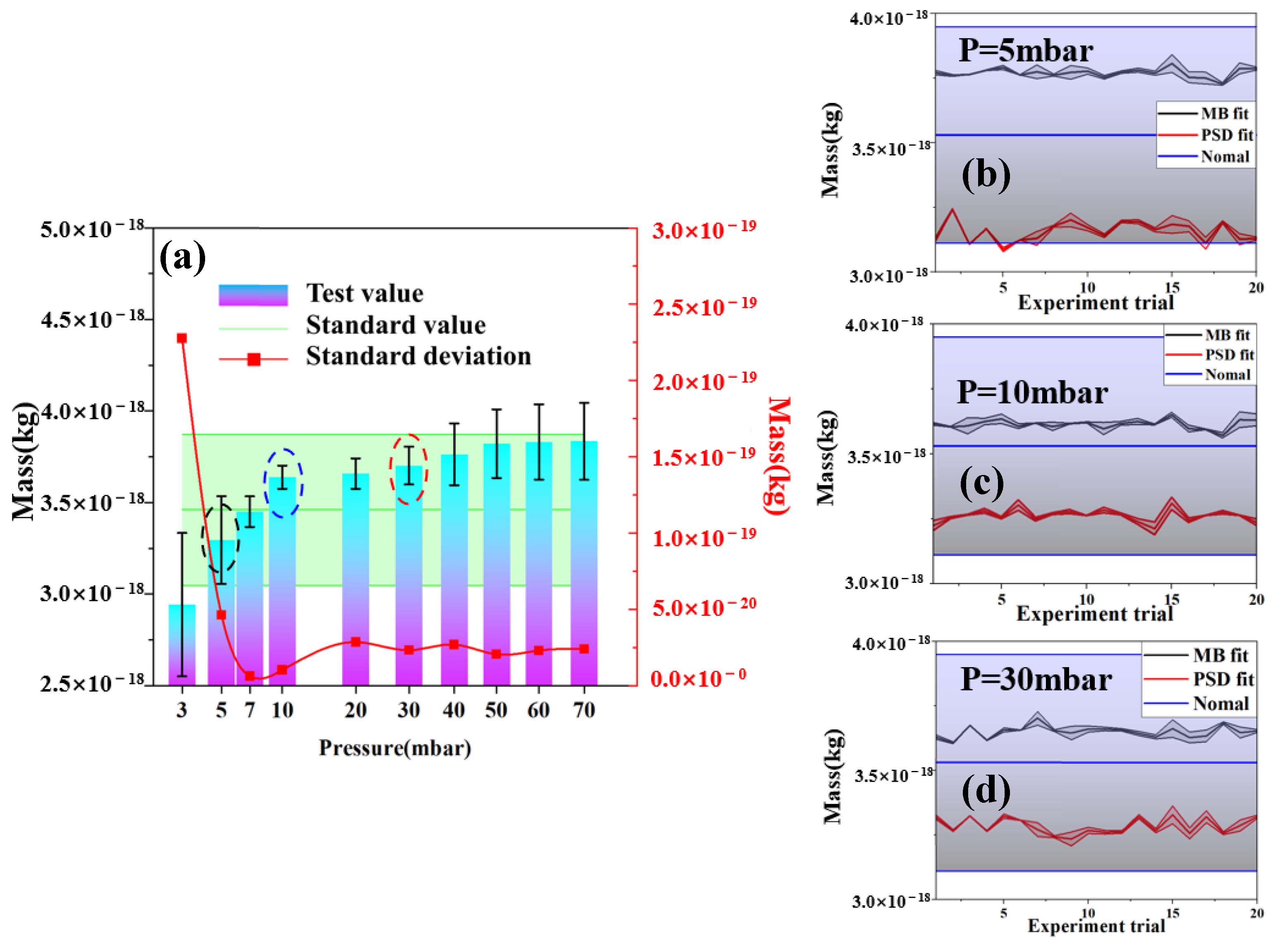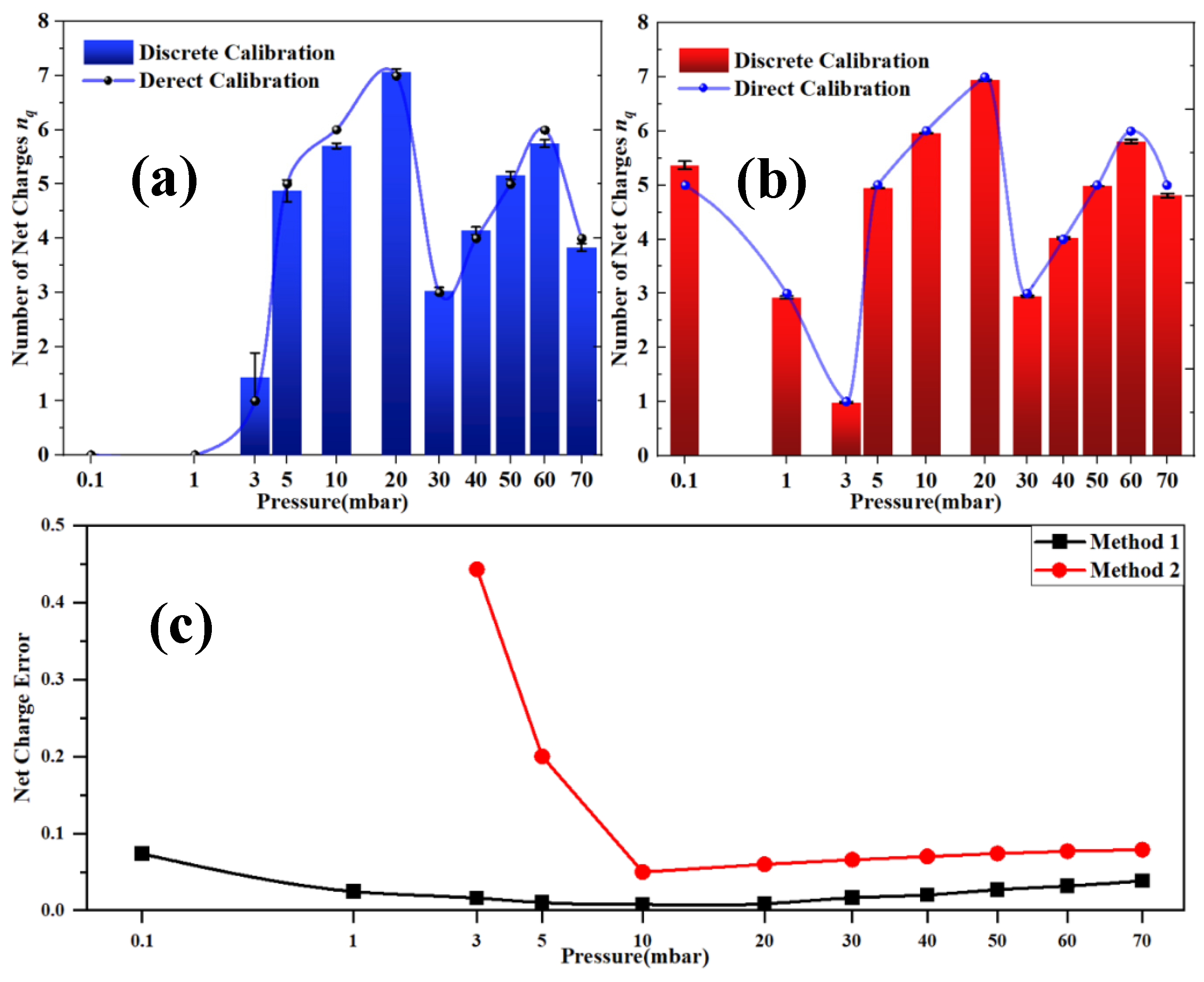Accurate, Fast, and Non-Destructive Net Charge Measurement of Levitated Nanoresonators Based on Maxwell Speed Distribution Law
Abstract
1. Introduction
2. Theory
2.1. Derivation of Maxwell Speed Distribution Law Based on Levitated Nanoscale Resonators
2.2. Electrical Drive Response and Net Charge Measurement
3. Externally Driven Net Charge Measurement Device for Levitating Particles
4. Experimental Results Display and Error Analysis
5. Conclusions
Author Contributions
Funding
Institutional Review Board Statement
Informed Consent Statement
Data Availability Statement
Acknowledgments
Conflicts of Interest
References
- Gieseler, J.; Gomea-Solano, J.R.; Magazzu, A. Optical tweezers—From calibration to applications: A tutorial. Adv. Opt. Photonics 2021, 13, 74–241. [Google Scholar] [CrossRef]
- Shi, Y.Z.; Song, Q.H.; Toftul, I. Optical manipulation with metamaterial structures. Appl. Phys. Rev. 2022, 9, 031303. [Google Scholar] [CrossRef]
- Yang, Y.J.; Ren, Y.X.; Chen, M.Z. Optical trapping with structured light: A review. Adv. Photonics 2021, 3, 034001. [Google Scholar] [CrossRef]
- Zheng, Y.; Zhou, L.M.; Dong, Y. Robust Optical-Levitation-Based Metrology of Nanoparticle’s Position and Mass. Phys. Rev. Lett. 2020, 124, 223603. [Google Scholar] [CrossRef]
- Blakemore, C.P.; Rider, A.D.; Roy, S. Precision Mass and Density Measurement of Individual Optically-Levitated Microspheres. Phys. Rev. Appl. 2019, 12, 024037. [Google Scholar] [CrossRef]
- Li, C.H.; Jing, J.; Zhou, L.M. Fast size estimation of single-levitated nanoparticles in a vacuum optomechanical system. Opt. Lett. 2021, 46, 4614–4617. [Google Scholar] [CrossRef]
- Schellenberg, B.; Behbahani, M.M.; Balasubramanian, N. Mass and shape determination of optically levitated nanoparticles. Appl. Phys. Lett. 2023, 123, 114102. [Google Scholar] [CrossRef]
- Chen, P.; Li, N.; Chen, X.F. Mass measurement under medium vacuum in optically levitated nanoparticles based on Maxwell speed distribution law. Opt. Express 2024, 32, 21806–21819. [Google Scholar] [CrossRef]
- Barredo, D.; Lienhard, V.; Leseleuc, S.D. Synthetic three-dimensional atomic structures assembled atom by atom. Nature 2018, 561, 79–82. [Google Scholar] [CrossRef]
- Kaufman, A.M.; Ni, K.K. Quantum science with optical tweezer arrays of ultracold atoms and molecules. Nat. Phys. 2021, 17, 1324–1333. [Google Scholar] [CrossRef]
- Pate, J.M.; Goryachev, M.; Chiao, R.Y. Casimir spring and dilution in macroscopic cavity optomechanics. Nat. Phys. 2020, 16, 1117–1122. [Google Scholar] [CrossRef]
- Shen, Y.J.; Wang, X.J.; Xie, Z.W. Optical vortices 30 years on: OAM manipulation from topological charge to multiple singularities. Light-Sci. Appl. 2019, 8, 90. [Google Scholar] [CrossRef] [PubMed]
- Gao, D.L.; Ding, W.Q.; Nieto-Vesperinas, M. Optical manipulation from the microscale to the nanoscale: Fundamentals, advances and prospects. Light-Sci. Appl. 2017, 6, e17039. [Google Scholar] [CrossRef] [PubMed]
- de Leseleuc, S.; Lienhard, V.; Scholl, P. Observation of a symmetry-protected topological phase of interacting bosons with Rydberg atoms. Science 2019, 365, 775–780. [Google Scholar] [CrossRef] [PubMed]
- Barredo, D.; de Léséleuc, S.; Lienhard, V. An atom-by-atom assembler of defect-free arbitrary two-dimensional atomic arrays. Science 2016, 354, 1021–1023. [Google Scholar] [CrossRef]
- Berlin, A.; Blas, D.; D’Agnolo, R.T. Detecting high-frequency gravitational waves with microwave cavities. Phys. Rev. D 2022, 105, 116011. [Google Scholar] [CrossRef]
- Rider, A.D.; Moore, D.C.; Blakemore, C.P. Search for Screened Interactions Associated with Dark Energy below the 100 μm Length Scale. Phys. Rev. Lett. 2016, 117, 101101. [Google Scholar] [CrossRef]
- Ma, X.; Jannasch, A.; Albrecht, U.R. Enzyme-Powered Hollow Mesoporous Janus Nanomotors. Nano Lett. 2015, 15, 7043–7050. [Google Scholar] [CrossRef]
- Hoekstra, T.P.; Depken, M.; Lin, S.N. Switching between Exonucleolysis and Replication by T7 DNA Polymerase Ensures High Fidelity. Biophys. J. 2017, 112, 575–583. [Google Scholar] [CrossRef]
- Truppe, S.; Williams, H.J.; Hambach, M. Molecules cooled below the Doppler limit. Nat. Phys. 2017, 13, 1173–1176. [Google Scholar] [CrossRef]
- Anderegg, L.; Augenbraun, B.L.; Chae, E. Radio Frequency Magneto-Optical Trapping of CaF with High Density. Phys. Rev. Lett. 2017, 119, 103201. [Google Scholar] [CrossRef] [PubMed]
- Mitra, D.; Vilas, N.B.; Hallas, C. Direct laser cooling of a symmetric top molecule. Science 2020, 369, 1366–1369. [Google Scholar] [CrossRef]
- Millikan, R. The isolation of an ion, a precision measurement of its charge, and the correction of Stokes’s law. Science 1910, 32, 436–448. [Google Scholar] [CrossRef]
- Kamble, S.; Agrawal, S.; Cherumukkil, S. Revisiting Zeta Potential, the Key Feature of Interfacial Phenomena, with Applications and Recent Advancements. ChemistrySelect 2022, 7, e202103084. [Google Scholar] [CrossRef]
- Rasmussen, M.K.; Pedersen, J.N.; Marie, R. Size and surface charge characterization of nanoparticles with a salt gradient. Nat. Commun. 2020, 11, 2337. [Google Scholar] [CrossRef]
- Sharma, A.; Basu, S.; Gupta, N. Detection of charge around a nanoparticle in a nanocomposite using electrostatic force microscopy. IEEE Trns. Dielectr. Electr. Insul. 2020, 27, 866–872. [Google Scholar] [CrossRef]
- Hempston, D.; Vovrosh, J.; Toros, M.; Winstone, G.; Rashid, M.; Ulbricht, H. Force sensing with an optically levitated charged nanoparticle. Appl. Phys. Lett. 2017, 111, 133111. [Google Scholar] [CrossRef]
- Zhu, S.C.; Fu, Z.H.; Gao, X.W. Nanoscale electric field sensing using a levitated nano-resonator with net charge. Photonics Res. 2023, 11, 279–289. [Google Scholar] [CrossRef]
- Ricci, F.; Cuairan, M.T.; Conangla, G.P. Accurate mass measurement of a levitated nanomechanical resonator for precision force sensing. Nano Lett. 2019, 19, 6711–6715. [Google Scholar] [CrossRef]
- Moore, D.C.; Rider, A.D.; Gratta, G. Search for Millicharged Particles Using Optically Levitated Microspheres. Phys. Rev. Lett. 2014, 113, 251801. [Google Scholar] [CrossRef]
- Kremer, O.; Califrer, I.; Tandeitnik, D.; Vonder, J.P.; Temporao, G.; Guerreiro, T. All-electrical cooling of an optically levitated nanoparticle. Phys. Rev. Appl. 2024, 22, 024010. [Google Scholar] [CrossRef]
- Frimmer, M.; Luszcz, K.; Ferreiro, S.; Jain, V.; Hebestreit, E.; Novotny, L. Controlling the net charge on a nanoparticle optically levitated in vacuum. Phys. Rev. A 2017, 95, 061801. [Google Scholar] [CrossRef]
- Wang, J.; Li, C.; Zhu, S.; He, C.; Fu, Z.; Zhu, X.; Chen, Z.; Hu, H. Rapid measurement of the net charge on nanoparticles in optical levitation system. Appl. Phys. Express 2023, 16, 066502. [Google Scholar] [CrossRef]
- Li, T.C.; Kheifets, S.; Medellin, D. Measurement of the instantaneous velocity of a brownian particle. Science 2010, 328, 1673–1675. [Google Scholar] [CrossRef]
- Nicolaenko, B.; Thurber, J.K.; Dorning, J. Rarefied gas models with velocity dependent collision frequencies. J. Quant. Spectrosc. Radiat. Transf. 1971, 11, 1007–1021. [Google Scholar] [CrossRef]
- Tiwari, P.K.; Kumar, R.; Halder, K. Maxwell-Boltzmann and Druyvesteyn Distribution Functions Expressing the Particle Velocity and the Energy in Sheath Plasmas. J. Russ. Laser Res. 2023, 44, 504–512. [Google Scholar] [CrossRef]
- Millen, J.; Monteiro, T.S.; Pettit, R. Optomechanics with levitated particles. Rep. Prog. Phys. 2020, 83, 026401. [Google Scholar] [CrossRef]
- Ricci, F.; Cuairan, M.T.; Schell, A.W.; Hebestreit, E.; Rica, R.A.; Meyer, N. A chemical nano-reactor based on a levitated nanoparticle in vacuum. ACS Nano 2022, 16, 8677–8683. [Google Scholar] [CrossRef]
- Hebestreit, E.; Frimmer, M.; Reimann, R.; Dellago, C.; Ricci, F.; Novotny, L. Calibration and energy measurement of optically levitated nanoparticle sensors. Rev. Sci. Instrum. 2018, 89, 033111. [Google Scholar] [CrossRef]
- Tian, Y.; Zheng, Y.; Liu, L.H.; Guo, G.C.; Sun, F.W. Medium vacuum feasible displacement calibration of an optically levitated Duffing nonlinear oscillator. Appl. Phys. Lett. 2022, 120, 221103. [Google Scholar] [CrossRef]








| Quantity | Value Zi | |
|---|---|---|
| T | 300 K | 5‰ a |
| 723.6 bit2Hz−1 | 0.12‰ b | |
| 8.4836 | 3.18% b | |
| 1.82 × 10−5 Pa.s | 0.03‰ | |
| E0 | 9.419 KV/m | 1.1% c [28] |
| kB | 1.38 × 10−23 J/K−1 | 5.72 × 10−7 |
| qe | 1.602 × 10−19 C | 6.1 × 10−9 |
| 4.47 kHz | 3.55% c | |
| τ | 0.015 s | 1 ppm d |
| m | 3.521 fg | 3.2% e |
| nq | 5.95 | 0.0113 (stat.) + 0.0282 (syst.) |
Disclaimer/Publisher’s Note: The statements, opinions and data contained in all publications are solely those of the individual author(s) and contributor(s) and not of MDPI and/or the editor(s). MDPI and/or the editor(s) disclaim responsibility for any injury to people or property resulting from any ideas, methods, instructions or products referred to in the content. |
© 2024 by the authors. Licensee MDPI, Basel, Switzerland. This article is an open access article distributed under the terms and conditions of the Creative Commons Attribution (CC BY) license (https://creativecommons.org/licenses/by/4.0/).
Share and Cite
Chen, P.; Li, N.; Liang, T.; He, P.; Chen, X.; Wang, D.; Hu, H. Accurate, Fast, and Non-Destructive Net Charge Measurement of Levitated Nanoresonators Based on Maxwell Speed Distribution Law. Photonics 2024, 11, 1079. https://doi.org/10.3390/photonics11111079
Chen P, Li N, Liang T, He P, Chen X, Wang D, Hu H. Accurate, Fast, and Non-Destructive Net Charge Measurement of Levitated Nanoresonators Based on Maxwell Speed Distribution Law. Photonics. 2024; 11(11):1079. https://doi.org/10.3390/photonics11111079
Chicago/Turabian StyleChen, Peng, Nan Li, Tao Liang, Peitong He, Xingfan Chen, Dawei Wang, and Huizhu Hu. 2024. "Accurate, Fast, and Non-Destructive Net Charge Measurement of Levitated Nanoresonators Based on Maxwell Speed Distribution Law" Photonics 11, no. 11: 1079. https://doi.org/10.3390/photonics11111079
APA StyleChen, P., Li, N., Liang, T., He, P., Chen, X., Wang, D., & Hu, H. (2024). Accurate, Fast, and Non-Destructive Net Charge Measurement of Levitated Nanoresonators Based on Maxwell Speed Distribution Law. Photonics, 11(11), 1079. https://doi.org/10.3390/photonics11111079







